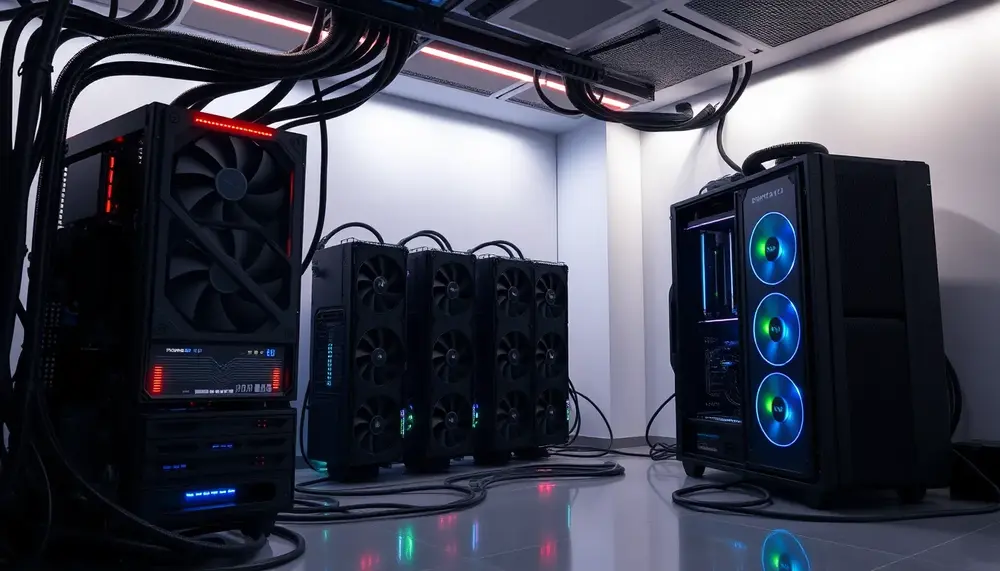Volume
Volume
Understand the term Volume in the context of Bitcoin mining is essential to grasp the overall mining process. In the world of cryptocurrency, specifically when focusing on Bitcoin mining, the term 'Volume' carries significant weight. So, let's delve deeper into this term.
What does 'Volume' mean in Bitcoin mining?
In cryptocurrency terms, volume refers to the number of Bitcoins traded in a certain period. Specifically, in Bitcoin mining, 'Volume' measures the number of transactions in the Bitcoin network that miners process. It provides an essential parameter, influencing miners' earnings and the smooth operation of the Bitcoin network.
Importance of 'Volume' in Bitcoin Mining
Understanding Volume is critical for Bitcoin mining, as it directly impacts miners' rewards. In periods of high trading volume, miners can earn more, as the number of transactions processed increases. Conversely, lower volume periods may decrease miners' earnings, as there are fewer transactions to process. More volume ensures that the Bitcoin network thrives – a crucial point given the decentralized nature of cryptocurrencies.
How 'Volume' affects Mining Difficulty
Another key aspect to note is that Volume affects the difficulty of Bitcoin mining. The Bitcoin network automatically adjusts the mining difficulty based on the volume of transactions. When the volume is high, meaning many transactions are happening, mining difficulty increases. Conversely, lower volume periods see a decrease in mining difficulty.
'Volume' and Market Impact
Finally, the Volume in Bitcoin mining directly influences the Bitcoin market. Significant volumes can indicate a highly active market, thus attracting more investors. Meanwhile, lower volumes might signal periods of uncertainty and lead to price swings.
In conclusion, 'Volume' in Bitcoin mining refers to the number of transactions processed in the network. This parameter plays a critical role in conducting efficient mining and ensuring the proper functioning of the Bitcoin network.
Blog Posts with the term: Volume

Strip mining is a surface mining method used to extract mineral deposits close to the earth's surface by removing overburden, with techniques like area and contour mining being particularly effective for coal extraction. While it offers efficiency and cost-effectiveness compared...

The Australian mining tax system is complex, involving a mix of federal and state taxes with royalties playing a key role, while the industry significantly contributes to Australia's economy through GDP growth, job creation, and global exports. Despite its relatively...

USDT DeFi Mining allows users to earn rewards by leveraging decentralized finance protocols using the stablecoin USDT, offering benefits like stable returns and passive income but also posing risks such as smart contract vulnerabilities and market volatility. This guide covers...

Infinity Hash is a cryptographic hash algorithm designed to optimize cryptocurrency mining by enhancing speed and security, ensuring data integrity through unique hash values. Despite its benefits like high security, efficiency, scalability, reduced collision risk, and future-proofing against threats such...

The article "Introduction to Zano Mining" provides a comprehensive guide for beginners on how to mine the privacy-focused cryptocurrency, Zano, efficiently by explaining its hybrid Proof-of-Work and Proof-of-Stake consensus mechanism. It covers essential tools such as mining hardware, software like...

The article explores the profitability of XRP mining, highlighting its unique consensus algorithm and how it differs from traditional cryptocurrencies like Bitcoin. It covers key factors influencing profitability such as transaction fees, network activity, hardware costs, energy consumption, market value...

The article explores the benefits of open source mining pool software for cryptocurrency miners, highlighting its transparency, cost-effectiveness, and community-driven development. It reviews top options in 2023 like Miningcore and Open-Source Monero/Cryptonote Mining Pool, emphasizing their unique features such as...

Understanding mining pool stats is crucial for optimizing cryptocurrency mining strategies, as it involves analyzing key metrics like hashrate and reward systems to make informed decisions. By evaluating factors such as pool performance, fee structures, and network stability, miners can...

Flux mining involves earning cryptocurrency by contributing to the network's security and efficiency, requiring specific hardware like powerful GPUs (e.g., NVIDIA RTX 3090) and software such as GMiner or LolMiner. Additionally, setting up a secure FLUX wallet is essential for...

XRP, created by Ripple Labs in 2012, is a pre-mined digital asset designed for fast and cost-effective cross-border payments using the Ripple Protocol Consensus Algorithm (RPCA) instead of traditional mining. Unlike Bitcoin's Proof of Work system, XRP relies on validators...

Solana mining, or staking, involves locking up SOL tokens to support the network using a Proof of Stake (PoS) mechanism rather than power-intensive hardware. Efficient Solana mining requires key components like powerful CPUs, adequate RAM (at least 64GB), fast SSDs,...

KHeavyHash is a specialized algorithm for Kaspa mining, known for its memory efficiency and compatibility with various hardware like GPUs and ASICs, allowing dual mining opportunities. Optimizing KHeavyHash involves tweaking hardware settings and software configurations to maximize hashrate while balancing...

Mining rewards per block are a crucial mechanism in cryptocurrencies like Bitcoin, incentivizing miners through newly minted coins and transaction fees to secure the network while maintaining decentralization. The halving process reduces these rewards by half approximately every four years,...

Tron USDT mining leverages the Tron blockchain and Tether (USDT) to offer a stable, efficient, and scalable environment for cryptocurrency miners. This guide covers the fundamentals of Tron and USDT, highlights benefits like low transaction fees and high speed, and...

